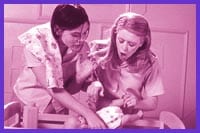Hail satire!
Laud Jamie Babbit for taking it upon herself to attempt a broad gay comedy, one of the first of its kind, establishing that gay culture has evolved to the point where can laugh at itself. Eulogize Jamie Babbit for boldly tackling the subject of subgroups within the community, a subject which might be comedy suicide.
A total absence of humour renders life impossible, wrote Colette, and while the community is not devoid of humor, wit tends to exist in one liners delivered like incoming mortar fire. Now we have Babbit’s But I’m A Cheerleader. It’s a full length, all gay movie. All the stereotypes, all of the time – where straight characters are plot devices rather than major roles. This alone makes Cheerleader notable.
Babbit, at the charitable age of 28, has already logged in two films, both shorts: Frog Crossing, a meditation on anti-human/pro-animal fanaticism, focused on a woman who would help frogs cross a highway, and Sleeping Beauties, the Barbie-infested story of a cosmetician at a mortuary which played on the sleeping beauty fairy tale as a venue for Babbit to explore her obsession with unavailable women.
Cheerleader follows Megan (Natasha Lyonne), who likes Georgia O’Keefe paintings, hates kissing her boyfriend and is a vegetarian – this adds up to dyke in the minds of her family and friends.
Off she’s shipped to True Directions, the local gay rehab camp for gender-wayward boys and girls. There she becomes an honour student who just can’t wait to be straight again so she can return to her former life as a cheerleader. That is, until she meets Graham (Clea DuVall).
Actually, Megan meets a veritable Wonderland of sexual stereotypes, a point which drew a great deal of heat in the multiple test screenings where Babbit handed out a four page questionnaire. “I definitely got shit from gay men who were offended by some of the stereotypes which proliferated in the movie,” says Babbit. “I can’t tell you how many gay men do not like Andre’s character, the actor-dancer-homosexual. He’s flamboyantly gay and ends up getting thrown out of the program because he’s a sissy.
“But I remember Harvey Fierstein (Bullets Over Broadway, Torch Song Trilogy), in The Celluloid Closet, when he said: ‘I’m a sissy and I’m happy with being that. Why do I have to be a butch guy?'”
There were no male characters when Babbit brought the idea of Cheerleader to writer, Brain Peterson, but together they created a world which they both knew would “push the line.” After all, it’s a movie about stereotypes headed up by the American dream girl icon: a cheerleader. The comedy grows out of the interaction between the types.
Babbit sees it as a “panoply of queer stereotypes conversing with each other. It reminds me of a cartoon in its hyper-real feeling.” The difference is that instead of the stereotypes (maybe at this point in time we should start using the word “archetypes”) being applied by outsiders, they’re now being applied from within.
The question comes down to whether the gay community finds it funny – yet.
Comedy, at its most exquisite, approaches the invisible line of truth and taste, coming to a halt at the bleeding edge. Beyond the image play in Cheerleader, Babbit found she pushed a critical button with the scene when Jan, the baggy-pant attired softball dyke, is in group therapy headed up by Mike (played by a dressed down RuPaul).
Jan asserts her heterosexuality. Mike tells her not yet. Jan maintains she’s never been gay and Mike responds with, “Jan, you were molested. Take a look at yourself.”
“People were really offended by RuPaul’s molestation remark,” Babbit concedes. “And yes, it rides the line because being molested is something you don’t want to make fun of. But on the other hand, I’ve met so many women who insist that they’re lesbians because they were molested. It’s a stereotype: If you’ve a bad experience with men, then you’re going to become a lesbian.”
Bathos beats pathos every time. The more extreme the setting (the designer ramped it up to a shrieking Barbie-pink), the easier to tell the story with all the nuanced irony the label crisis is generating these days.
“As a filmmaker I’m interested less in realism and more in hyper-realism.” As much as Cheerleader is comedy, it’s Babbit’s investigation of the energies invested in the maintenance of one’s image.
She see the process of coming out as “an everyday experience. You constantly have to do it because it comes up.” Once out, the struggle continues according to how you declare yourself. “There’s the insanity [within] the gay culture to affirm our rights. I see all the different sides and it’s a shame because it’s complicated.”

 Why you can trust Xtra
Why you can trust Xtra


